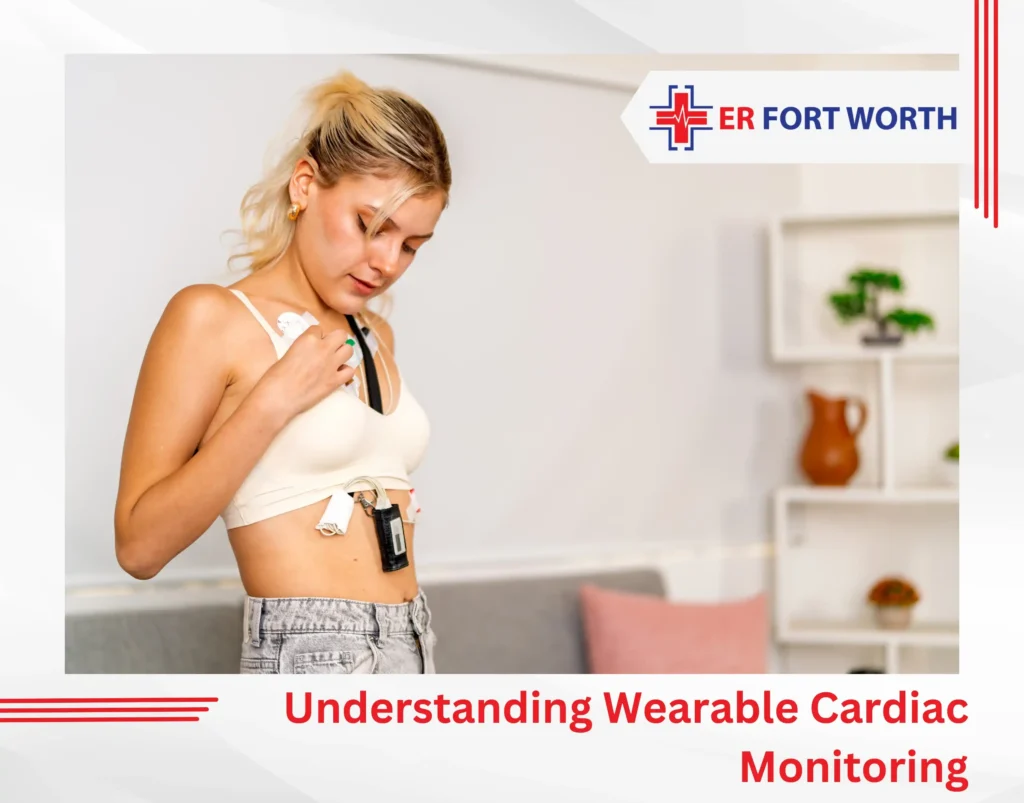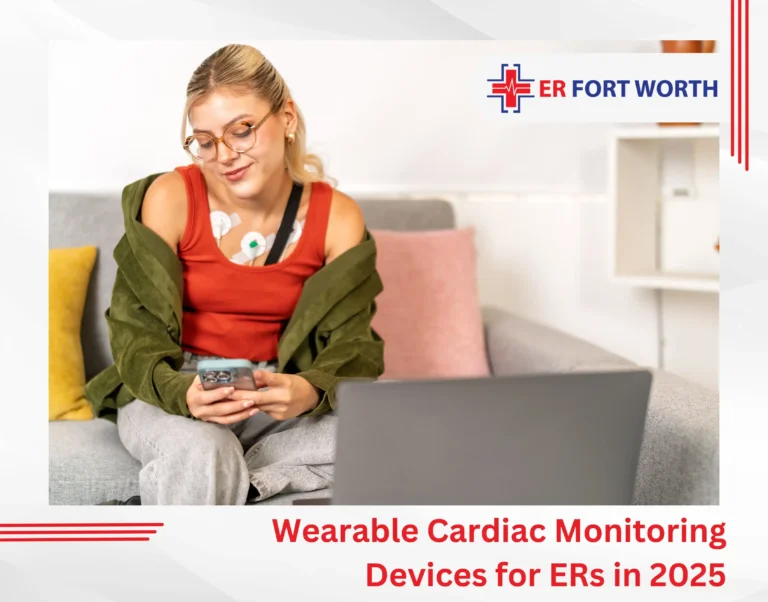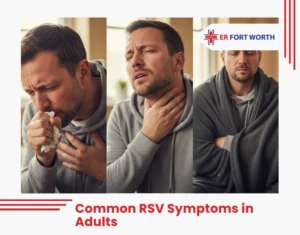Emergency rooms operate on one simple truth: time saves lives. Wearable cardiac monitoring technology is beginning to change how emergency physicians evaluate heart conditions.
Instead of waiting for symptoms to worsen or relying on periodic check-ups, doctors now have real-time access to their patients’ heart data.
These devices give ER teams additional information about heart rhythm and rate patterns, though integration with emergency care systems is still developing across healthcare facilities.
Understanding Wearable Cardiac Monitoring

Wearable cardiac monitoring uses electronic devices that continuously track heart activity, including heart rate, rhythm, and sometimes blood pressure and oxygen saturation.
These devices are worn on the wrist, chest, or as patches on the skin. In emergency medicine, they can provide valuable data that supplements traditional diagnostic methods like standard ECGs.
Current cardiac wearables include ECG patches, FDA-approved smartwatches, chest strap monitors, and specialized medical devices. While some newer systems can integrate with electronic health records, this capability varies significantly between healthcare facilities and device manufacturers.
Why Real-Time Heart Monitoring Matters in Emergency Care
Cardiac events can change rapidly, making immediate access to heart rhythm data valuable for emergency physicians. Traditional ECGs performed upon arrival provide important snapshots, but continuous monitoring can reveal patterns that single readings might miss.
Wearable cardiac monitoring can help identify intermittent arrhythmias and provide context about heart behavior before, during, and after emergency treatment.
6 Clinical Benefits of Wearable Cardiac Monitoring in the ER
Wearable cardiac monitoring transforms emergency care by providing real-time, continuous heart data. These devices help ER teams act faster, work smarter, and deliver more precise care.
1. Faster Diagnosis and Early Intervention
Continuous heart monitoring can help emergency physicians identify rhythm abnormalities like atrial fibrillation or ventricular tachycardia that might not appear during brief ECG readings. This additional data can support faster diagnostic decisions, though standard emergency protocols remain essential.
2. Improved Triage
Heart rhythm data can supplement clinical assessment during triage. A patient with concerning rhythm patterns may receive priority evaluation, while those with stable readings can be appropriately prioritized. This objective data supports, but doesn’t replace, clinical judgment.
3. Broader View of Heart Activity
Unlike snapshot readings from traditional ECGs, cardiac wearables show heart patterns over time. This can reveal intermittent arrhythmias or rhythm changes that occur during different activities or stress levels, providing valuable context for emergency physicians.
4. Patient Comfort & Mobility
Modern cardiac wearables are often less restrictive than traditional wired equipment. Patients can move more freely during monitoring, which may reduce anxiety and improve the overall emergency department experience.
5. Enhanced Pre-Hospital Communication
Ambulances equipped with wearable monitors can transmit live heart data to the ER during transport. By the time the patient arrives, the medical team already has a clear understanding of the situation and can begin targeted treatment without delay.
6. Accurate Documentation and Better Outcomes
These devices automatically log critical metrics, improving medical record accuracy and reducing the documentation burden on staff. Better data also supports hospital quality initiatives and long-term research aimed at refining emergency cardiac care.
The Technology Making It Happen
1. ECG Patch Monitors
Adhesive patches placed on the chest can record continuous ECG data for extended periods. In emergency settings, these devices help detect irregular heart rhythms and monitor patients after treatment. Some newer models offer wireless data transmission, though integration capabilities vary by facility.
2. FDA-Approved Smartwatches
Consumer devices like the Apple Watch Series 9 and Samsung Galaxy Watch have FDA clearance for basic heart rhythm monitoring and can detect atrial fibrillation. These devices may provide helpful background information when patients arrive at the ER, though they’re not designed for emergency medical diagnosis.
3. Chest Strap Monitors
Originally popular among athletes, chest strap heart rate monitors have been redesigned for medical-grade accuracy. Their use in ERs allows accurate ER heart rate tracking during physical assessments and post-stabilization monitoring.
4. Wearable Defibrillator Vests
These life-saving vests can detect deadly arrhythmias and automatically deliver a defibrillation shock. While rare, their use in high-risk patients awaiting implantable cardioverter-defibrillators (ICDs) is increasingly being integrated into ER care protocols.
5. Multi-Parameter Monitoring Patches
Advanced patches can track multiple vital signs including heart rate, oxygen levels, and in some cases blood pressure. These research-grade devices are beginning to appear in clinical settings, though widespread adoption remains limited.
How ERs Are Beginning to Use This Technology
Seamless Data Flow
Some emergency departments are exploring integration of cardiac wearables data with their electronic health record systems. However, most facilities still require manual data entry from cardiac monitors. While seamless data flow represents a goal for many healthcare systems, implementation remains inconsistent across different hospitals and device manufacturers.
Basic Alert Systems
Certain cardiac monitoring devices include built-in algorithms that can flag potential rhythm abnormalities. These alerts may help medical staff identify concerning patterns, though emergency physicians typically rely on their clinical expertise and standard monitoring equipment for critical decisions.
Remote Monitoring Capabilities
A small number of healthcare systems are piloting programs that use wearable cardiac data to support telemedicine consultations. This emerging capability may help physicians in rural areas make decisions about whether patients need emergency transport, though such programs are not yet widely available.
Real-World Applications in Emergency Care

Chest Pain Cases
When someone calls 911 with chest pain, paramedics can now attach ECG patches that transmit heart data to the hospital during transport. This gives ER teams a head start on diagnosis and treatment planning. By the time the patient arrives, doctors already know if they’re dealing with a heart attack and can activate the cardiac team immediately.
Fainting and Dizziness
Unexplained fainting is one of the trickiest problems in emergency medicine. The underlying heart rhythm problems that cause fainting are often intermittent and disappear by the time patients reach the ER. Wearable monitors solve this by providing continuous monitoring that can capture these elusive events.
After Cardiac Arrest
Once a cardiac arrest patient is stabilized, they need intensive monitoring to watch for recurring problems. Cardiac wearable devices provide this continuous surveillance, alerting medical teams to any concerning changes in heart rhythm or function.
Pediatric and Elderly Patient Considerations
These devices are particularly helpful for children and elderly patients who might be uncomfortable with traditional monitoring equipment. The non-invasive, wireless nature of wearable monitors reduces anxiety and improves the overall experience for these vulnerable populations.
Future Directions in ER Heart Rate Tracking
![]()
Predictive Medicine
Researchers are exploring whether advanced data analysis might help identify patterns that precede cardiac events. While promising in research settings, clinical applications for emergency care remain years away and face significant regulatory and technical challenges.
Complete Health Pictures
Future devices will monitor even more vital signs simultaneously, giving doctors comprehensive health profiles rather than just heart data.
Automated Response
Advanced systems might eventually connect monitoring devices to automated treatment systems, potentially delivering medications or adjusting device settings automatically when problems are detected.
Universal Connectivity
Industry efforts to create universal standards will make device integration simpler and enable seamless data sharing between different healthcare providers.
What This Means for Patients
For patients, wearable cardiac monitoring means:
- Faster treatment when every second counts
- More comfortable monitoring without bulky equipment
- Better outcomes through early problem detection
- Reduced anxiety with continuous professional oversight
- Improved safety through 24/7 cardiac surveillance
- Integration with emergency care varies by facility and device type
What This Means for Healthcare Providers
For doctors and nurses, these devices provide:
- Better diagnostic information for faster decision-making
- Improved workflow efficiency through automated data collection
- Enhanced patient safety through continuous monitoring
- Reduced documentation burden through automated record-keeping
- Better resource allocation through objective patient prioritization
Emergency departments continue to evaluate how wearable cardiac monitoring technology might enhance patient care while maintaining the highest standards of emergency medical treatment.
FAQs
1. What is the best wearable device to monitor your heart?
The best wearable cardiac monitoring device depends on your needs. For medical-grade accuracy, devices like the Zio Patch or BioIntelliSense BioSticker offer continuous ECG tracking and are used in clinical settings.
For general use, smartwatches like the Apple Watch Series 9 and Fitbit Sense 2 provide reliable real-time heart monitoring and are FDA-cleared for detecting irregular heart rhythms.
2. Do wearable heart monitors work for pediatric or elderly patients in the ER?
Absolutely. Many wearable cardiac monitoring tools are designed for comfort and minimal invasiveness, making them ideal for children and older adults during emergency evaluations.
3. How is patient data from cardiac wearables integrated into ER systems?
Modern ERs use secure systems that sync with cardiac wearables to import data directly into electronic health records. This integration supports timely diagnosis and treatment planning.




